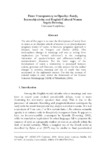Mostrar o rexistro simple do ítem
From Transparency to Opacity: Surely, Intersubjectivity and English Cultural Norms
| dc.contributor.author | Downing, Angela | |
| dc.date.accessioned | 2016-07-15T08:35:32Z | |
| dc.date.available | 2016-07-15T08:35:32Z | |
| dc.date.issued | 2008 | |
| dc.identifier.citation | AEDEAN 2008, 31: 677-687 ISBN-978-84-9749-278-2 | |
| dc.identifier.isbn | 978-84-9749-278-2 | |
| dc.identifier.uri | http://hdl.handle.net/2183/17081 | |
| dc.description.abstract | [Abstract] The aim of this paper is to trace the development of surely from its status as an objective adverb of manner to an (inter)subjective pragmatic marker of stance. A discourse -pragmatic approach is adopted, based on Traugott and Dasher (2002). This contemplates changes in meanings and uses as arising from implicatures (or “invited inferences”) in the strategising interaction of speakers/writers and addressees/readers in communicative situations. For the latter stages of the development of surely a relationship is postulated between culture, grammar and discourse, to help account for the radical changes in position, meaning and use of surely that were accelerated in the eighteenth century. For this the concept of cultural scripts is used, within the framework of the Natural Semantic Metalanguage (NSM) of Wierzbicka (2006). | |
| dc.language.iso | eng | |
| dc.publisher | Universidade da Coruña | |
| dc.title | From Transparency to Opacity: Surely, Intersubjectivity and English Cultural Norms | |
| dc.type | info:eu-repo/semantics/conferenceObject | |
| dc.rights.access | info:eu-repo/semantics/openAccess |






